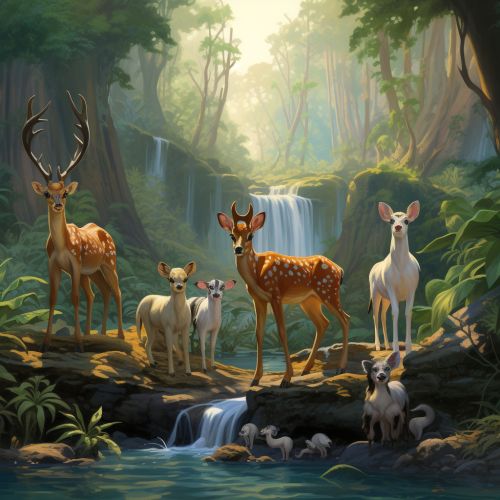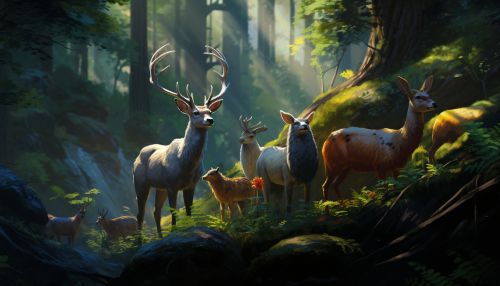Artiodactyla
Taxonomy and Evolution
Artiodactyla, also known as even-toed ungulates, is a large and diverse order of mammals that includes over 220 species, divided into 10 families. The name "Artiodactyla" is derived from the Greek words 'artios' (even) and 'daktylos' (finger/toe), referring to the characteristic feature of this group: most species have an even number of toes on each foot.
The Artiodactyla order is believed to have evolved during the early Eocene, approximately 54 million years ago. The earliest known artiodactyls were small, forest-dwelling creatures that resembled modern-day chevrotains or mouse deer. Over time, these primitive artiodactyls diversified into a wide array of forms, including the massive, horned ungulates like the American bison and the African buffalo, as well as the long-legged, fleet-footed gazelles and pronghorns.


Anatomy and Physiology
Artiodactyls are characterized by a number of unique anatomical features. Most notably, they possess an even number of toes on each foot, usually two or four, with the third and fourth digits being the most developed and bearing the weight of the animal. This is in contrast to the perissodactyls, or odd-toed ungulates, which have an odd number of toes.
Artiodactyls have a highly specialized digestive system adapted for fermenting plant material. Most species are ruminants, possessing a complex, four-chambered stomach that allows them to extract nutrients from plant material through a process of fermentation. Non-ruminant artiodactyls, such as pigs and peccaries, have a simpler, monogastric digestive system.
The teeth of artiodactyls are also adapted for their herbivorous diet. They typically have high-crowned molars and premolars for grinding plant material, and a diastema (gap) between the incisors and the molars, which aids in the manipulation and processing of food.
Behavior and Ecology
Artiodactyls inhabit a wide range of habitats, from arctic tundra to tropical rainforests, and from coastal marshes to desert environments. They are primarily herbivorous, feeding on a variety of plant material including grasses, leaves, fruits, and bark. Some species, such as the hippopotamus and the warthog, are also known to consume small amounts of animal matter.
Artiodactyls exhibit a wide range of social behaviors. Some species, such as the bighorn sheep and the moose, are largely solitary or live in small family groups. Others, like the African buffalo and the wildebeest, form large, complex herds. Many artiodactyls are also known for their elaborate mating rituals, which often involve displays of strength or agility, and can include vocalizations, posturing, and physical combat.
Conservation
Many species of artiodactyls are of conservation concern. Habitat loss, hunting, and competition with livestock are among the major threats facing these animals. Some species, such as the saiga antelope and the addax, are critically endangered, with only a few thousand individuals remaining in the wild. Conservation efforts for artiodactyls typically involve habitat protection and restoration, hunting regulation, and captive breeding programs.
